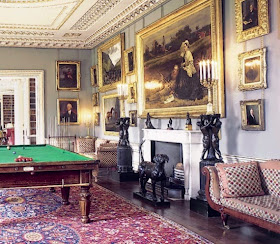
Peter has done really well over the last month, finding not only the grand piano, but also a billiard table. It is identical to the one below:

Peter bought it from a pool enthusiast who had not long since finished lovingly restoring it. But now with a young family, he has found that he no longer has time to play, and was looking for a good home for it. I can't think of a better home than WBP. Now we just need to set about sourcing materials to decorate the room.
We have already chosen the lighting, which is being hand manufactured in the UK by craftsman David John:
Above: Billiard lights with green glass shades in French gold finish
Below: Picture lights in French gold finish.
and we have our hunting trip booked to bring back a stag's head (and some venison for the freezer).
Here are some other billiard room design ideas...
Above Images from Pinterest and Tumblr
On one side of the hearth we have a door leading to the gold drawing room, on the other side of the hearth we will mirror with fearless symmetry the architrave of that doorway, but instead of there being a door, the architrave will frame a cue holder, topped with a score keeper, similar to these ideas...

.jpg)




























.jpg)
.jpg)
.jpg)

.jpg)


















